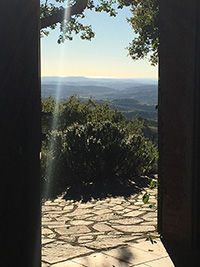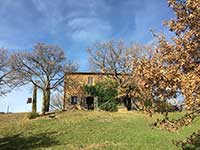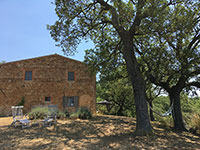
N L |
From Chianti and Brunello di Montalcino to Vino Nobile di Montepulciano, Super Tuscans and Montecucco D.O.C. |
|
||||||
Italy is one of the largest producers of wines. Its climate, soil and very old traditions make Italy a natural wine growing nation. The wines are as personal as a name, as different as the colors of the rainbow and as much a part of Italian life as almost 3,000 years of tradition can make them. The Etruscans of North-Central Italy, who created one of the peninsula's earliest civilizations, left evidence of how to make wine. The Greeks who soon after established themselves in the South gave Italy the name Enotria (the land of wine). Tuscany (Toscana) is known mainly for Chianti, while Tuscany's wine of greatest stature is Brunello di Montalcino.
|
||||||||
One of the best places to slow travel in Tuscany is the Maremma, with its exquisite nature, small hillside villages, its epic countryside, cuisine and excellent wines. Podere Santa Pia is located in a strategic position, only a short distance from a large number of sites of historical and cultural interest.
|
|
|||||||
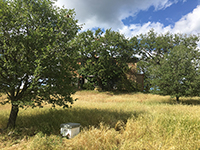 |
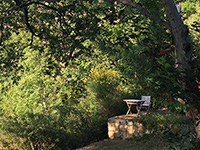 |
|||||||
Podere Santa Pia, a formal cloister in the Tuscan Maremma is situated on the outskirts of Castiglioncello Bandini.
|
Celebrare il dolce far niente |
The first bee hive in the garden What should you do if you see a swarm? |
Podere Santa Pia boasts a beautiful garden, with plenty of secluded corners for writers or readers |
|||||
Podere Santa Pia was named after Pia de' Tolomei, a woman with an intriguing story. According to some legends, the beautiful Pia di Tolomei, Nello d'Inghiramo de Pannocchieschi's sorrowful wife, crossed the Ponte della Pia to go into exile in Maremma, at Castello della Pietra. There her husband ordered the execution of his innocent wife Pia, in order that he could marry his mistress Margherita Aldobrandeschi, Contessa of Sovana and Pitigliano. |
||||||||
“Deh, quando tu sarai tornato al mondo, |
“O pray, when you return to the world, and are rested from your long journey,” followed the third spirit after the second, “remember me, who am La Pia. Siena made me, Maremma unmade me: this is known to him who after due engagement wedded me with his ring.” |
|||||||
| Montecucco D.O.C., one of the most promising designations in Italy | ||||||||
The Maremma is extremely different than Northern Tuscany. While the north boasts such spectacular cities as Florence, Siena and Lucca, the region also received hoards of tourists and can be uncomfortably crowded in high season, indeed even in low season. Wine regions in Northern Tuscany, such as Chianti Classico, have extremely well developed wine tourism and most cellars open to the general public. The Maremma, on the other hand, is far more exclusive. Few cellars open to the "general public" and the region is noticeably less touristy. This is why the Maremma, for serious wine lovers is such an attractive region to visit. Towns like Castiglione della Pescaia (with its charming fishing port and castle), Pitigliano (an amazing village completely carved out of the rocky outcrop below, an ancient Jewish village) and Massa Maritima (with its quaint cobblestoned, Medieval streets) are all fabulous little gems- they are virtually free of the crowds.Maremma is an extremely interesting sub region of Tuscany for food and wine lovers to visit. Although for centuries it was considered unfit for vineyards, in the past few decades this coastal area has become one of the most ultra exclusive wine producing regions of Italy. Therefore DOC Montecucco is one of the most promissing designation in Italy. (DOC : Denominazione di Origine Controllata – Trade name guaranteeing quality of wine. It was established in 1998 as an instrument of valorization and control which guarantees the consumer with the highest standards which characterizes Montecucco wines.
|
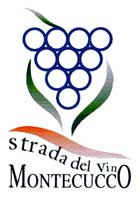 |
|||||||
The acknowledgment of the Designation of Origin to the Montecucco wine dates back to 1998 but the efforts by the producers, who had many years before understood the potentialities of the territory, began long ago. Unfortunately bureaucracy is often slower then the things it protects, so these wines have only recently been acknowledged RDO, even if good quality wines have already been produced for a long time. In facto before 1998 the wine producers, not many but very dedicated, gazed at these perfect hills with attention. The wines already belonging to the old Geographic denomination Montecucco - typologies: red, rose, white were already of good quality and did not make a poor impression next to the other Tuscan RDOs.
The road to the achievement of the Registered Designation of Origin has been hard but necessary to censure the oenological dignity already acquired by the producers. The typologies expected by the regulations faithfully portray the situation existing before the acknowledgment, with the Sangiovese wine in a prominent position concerning the red and other improving vineyards to follow, while as regards the whites next to the traditional Trebbiano there is the promising Vermentino, vinified in almost complete purity. The DOC regulations are in exact accordance with the situation pre-existent to the DOC recognition.
|
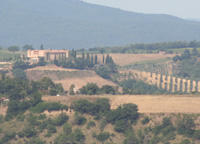 Castello Colle Massari, view from Podere Santa Pia |
|||||||
In the Montecucco area, you'll frequently see roses planted along the edge of vineyards. Traditionally they've served as an early warning system to protect the grapevines — the equivalent of a miner's canary. And they're beautiful.
|
||||||||
|
Organic or biological wine in southern Tuscany weergeven op een grotere kaart
|
||||||||
More and more wineries believe in maintaining the delicate chain of a balanced biological ecosystem and use organic or sustainable approaches to winemaking.
Strada del Vino di Montecucco - Toscana |
||||||||
| The Montecucco Wine Trail runs through a vast area situated on the slopes of Mount Amiata, which has its centre at Cinigiano, lying between the Maremma region and Amiata. The vineyards are situated on the southwest hillsides of the Amiata Mountain, directly opposite the Brunello slopes; the two enjoy the same microclimate. The seven Comuni which produce the Montecucco DOC wine are all to be found in the Province of Grosseto, in South Tuscany, and are, besides Cinigiano: Civitella Paganico, Campagnatico, Castel del Piano, Arcidosso, Seggiano and Roccalbegna. The Montecucco wine trail (La Strada del Vino Montecucco) consists of a main roadway with five turn-offs. It can also be found on the official site of Strada del Vino Montecucco - Montecucco Wine Trail. This little-known area strikes the visitor as a kind of enchanted garden, with endless discoveries to be made - a different Tuscany, the real one, in which tradition and innovation are combined. It is an unspoilt landscape whose natural dignity and resources have been respected, especially in more recent wine-growing. Apart from Montecucco DOC and Maremma Toscana IGT wines, the area also produces olive oil (IGP Toscano - Seggiano is particularly worth a mention), chestnuts, which are shortly to receive IGP recognition Mount Amiata Chestnut), mushrooms, notably the ceps and ovolo species, and excellent honey. The Trail is arranged in one main itinerary and five mini-itineraries which wind through the most beautiful and interesting parts of the area from the viticultural, historic, cultural and environmental point of view. The following towns are touched upon: Paganico, Sasso d'Ombrone, Poggi del,Sasso, Montecucco, Cinigiano, Porrona, Montenero, Montegiovi, Montelaterone, Castel del Piano and Seggiano.
|
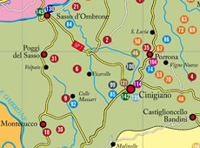 Strada del vino Montecucco |
|||||||
| Paganico - Sasso d'Ombrone - Poggi del Sasso - Montecucco - Cinigiano - Porrona - Montenero - Montegiovi - Montelaterone - Castel del Piano - Seggiano. The itinerary passes through the most important Montecucco DOC wine-growing zones. Setting off from Paganico, a lively, modern town with an interesting four-gated wall dating from the fourth century, we reach the Monteverdi farm and then on to Sasso d'Ombrone, with its imposing bridge and medieval gate. We then climb up to Poggi del Sasso, a little rural town and centre of Montecucco wine production. This area is abundant in vineyards, cellars and wineries, but is also noteworthy for the beautiful castles at Vicarello and Colle Massari. A few kilometers from Poggi del Sasso is the Montecucco Farm which has lent its name to the eponymous DOC wine. This area, in front of Mount Amiata, is the heart of wine-growing activities. Numerous holiday farmhouses, traditional trattorie, and extensive wildlife make this area very rewarding from the hunting and culinary point of view. Nearby is the Porrona Castle, a stunning village whose image has been borrowed to promote DOC Montecucco wine. Montenero is the other DOC Montecucco "capital",and it houses the Museum of Wine and Vine. There are many cellars where wine, oil and other local products may be savoured. During the summer in a park in Montenero an open-air wine bar is set up for the tasting of Montecucco wine. Also here one may visit the seventeenth century well and the town wall gate. Leaving Monyenero and proceeding towards Mount Amiata we arrive in the Montegiovi area - a veritable museum of viticulture, with its little groves of mixed olives and patches of vines. In fact a real vine museum is planned for the conservation of germoplasm and particularly autochthonous species of grapevine. Also to be admired is the centre of Montegiovi, where on the last Sunday of September a country fair, devoted to Bruschetta, is held. Montelaterone is the last village before Castel del Piano - the incredibly well-preserved centre is worth a visit Then Castel del Piano itself: it is one of the most important towns of Mount Amiata, and the visitor should seek out Palazzo Nericci, which is soon to be a museum dedicated to peasant culture, the Castiglionese Gate, Corso Nasini, the Monaci, Cantucci, Bruni, Alluigi and Cerboni Palaces, the Teatrino and the Loggia della Mercanzia. The trail finishes up in Seggiano, or rather a little further on - another area given over to vine and olive-growing. Here the Logge del Mercato and the historically important centre, with its cellars carved out of rocks, are worth seeing, as are the charming Potentino Castle and Daniel Spoerri's unusual "Garden of Art". One should also visit the Olivastra Seggianese olive-pressing works where the only single-variety Tuscan oil, denominated "Seggiano", is produced from the locally cultivated Amiata olive. The annual Oil Festival is held on the first Sunday of December. |
 Castel Porrona, a charming medieval village dating back to the 11th century, between Cinigiano and Castiglioncello Bandini and Podere Santa Pia |
|||||||
| Monte Antico - Casenovole - Casal di Pari - Bagno di Petriolo
This trail is particularly rich in history, as the Castles of Monte Antico and Casenovole testify. We wind along a route not far from the River Ombrone, in an area once famous for wine-growing and which is today regaining it old splendor and vocation. The little towns of Pari and Casal di Pari, veritable rural gems, are a must, as is the charming spa of Petriolo, set in the Nature Reserve of Basso Merse.
Campagnatico is the starting point for this trail - this important Maremma town was even mentioned by Dante. The Civic Theatre, the Aldobrandesca Rock and the Pretorio Palace should all be seen. Views of olive groves and vineyards are splendid along this route, against the delightful backdrop of the Maremma plain. The unusual Palio dei Ciuchi (donkey race) is held every September. Castiglioncello Baldini - Stribugliano - Cana |
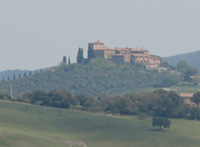 Castello di Casenovole in between Civitella Paganico, Pari and Monte Antico |
|||||||
| This delightful trail is centred on Castiglioncello Baldini, which is dominated by a splendid castle - the castle's cellars, currently undergoing restoration, are worth a visit. The trail touches on the Poggio all'Olmo and Monte Labbro Nature Reserves. Then we reach the town of Stribugliano, which is part of the Comune of Arcidosso, and which gives the impression of a huge terrace with its breathtaking view. Cana, a village of Etruscan origin in the Comune of Roccalbegna is a DOC Montecucco zone. On the third Sunday of every October is held a festival dedicated to the Chestnut. The seventeenth century Medici Cistern should be seen. | ||||||||
Sasso d'Ombrone - Cingiano - Monticello d'Amiata This route through the Cinigiano area follows the old mountain road linking the plain with Mount Amiata, and thus linking corn with chestnuts. However, also the grape is ubiquitous here. Sasso d'Ombrone, originally Sasso di Maremma, is a little village on the River Ombrone, in which an unusual festival is held on the third Sunday of every September - the Festival of the Eel ! Ponticello Amiata is a well-preserved, historically interesting town with a delightful ethnographic "house-museum". Here the chestnut is king, and a festival is held in its honour onthe second sunday of every October.
|
 |
|||||||
 |
||||||||
| Az. Agricola PARMOLETO di Duilio e Leonardo Sodi |
||||||||
Member companies of the DOC Montecucco
|
||||||||
AZIENDA AGRICOLA AGRITURISMO ASSOLATI | Loc. Pod. Assolati, 58040 - Montenero AGRITURISMO LA BANDITACCIA | Podere la Banditaccia, 58047 Monticello Amiata AZIENDA AGRICOLA BASILE | Podere Montemario, 58044 Cinigiano AZ. AGR. BEGNARDI - SAPORI DI MONTEANTICO | Podere Camporosso, 34 58030 Monteantico AZ. AGR. CAMPINUOVI | Podere Campinuovi, 58044 Cinigiano AZ. AGR. CAPANNE RICCI | Loc. Capanne Ricci, 58044 Cingiano AZIENDA AGRICOLA CASA VACANZE CASALE POZZUOLO | Pod. Pozzuolo Borgo S. Rita 58044 Cinigiano AZ. AGR. AGRITURISMO LE CALLE | Loc. La Cava , 58040 Poggi del Sasso AZ. AGR. LE CAPANNACCE | Le Capannacce, Casal di Pari AZ. AGRICOLA AGRITURISMO CIVETTAIO | Loc. Podere Civettaio, 58045 Civitella Paganico |
||||||||
 Azienda Colle Massari, cantina |
AZ. AGR. COLLE MASSARI S.P.A. | Poggi del Sasso, 58044 Cinigiano Tel. 0564 990496 Fax. 0564 990498 | e-mail info@collemassari.it | www.collemassari.it
|
|||||||
AZ. AGR. FUSI ORIO E IRIO | Podere Santa Chiara, 58040 Montenero AZ. AGR. IL GALLETTO | Loc. Santa Rita, 58044 Cinigiano AZ. AGR. LANZINI E SACCHI | Loc. Fabiani, 58040 Montenero AZ. AGR. FATTORIA LA LECCIAIA di pacini mauro | Loc. Poggio Giannino, 58042 Campagnatico AZ. AGR. FRANCO MASCELLONI | Loc. Fabiani, 58040 Montenero AZ. AGR. NICCOLÒ MASCELLONI | Podere Coniella, 58040, Montenero AZ. AGR. FABIO MONACI GABRIELLA LANZINI | Pod. Vignacci,22 58033 Castel del Piano AZ. AGR. MONTEANTICO | Loc. Monteantico Pod. 216, 58045 Civitella Paganico AZ. AGR. MONTEBENDICO | Via Vittorio Veneteo Castel del Piano AZ. AGR. STENTI | Via Traversa 12, 2 Loc. Stenti 58033 Montenero (GR) TENUTA DI MONTECUCCO | AGRITURISMO MONTECUCCO | Loc. Montecucco 13, 58040, Sasso d'Ombrone AZ. AGR. ORCIAVERDE | Podere Ente Maremma 369, 58040 Montenero AZ. AGR. PARMOLETO | Podere Parmoletone, 58040 Montenero | www.parmoleto.it AZ. AGR. DARIO PASQUI AGRICOLTORE | Podere Montesalario, 58040 Montenero AZ. AGRARIA PERAZZETA | Via dell'Aia, 14, 58040 Montenero AZ. AGRICOLA E AGRITURISMO PETEGLIA | Podere Peteglia, 58033 Montenero d'Orcia AZ. AGR. PIANDIBUGNANO | Loc. Pian di Bugnano Seggiano AZ. AGR. PODERE IL CASINO | Loc. Podere il Casino 58038 Seggiano AZ. AGR. PODERE POGGIO AL GELLO | Pod. Poggio al Gello, Loc. Il Gello, 58048 Paganico AZ. AGR. LA PODERINA TOSCANA | Loc. Poderina 58030 Montegiovi AZ. AGR. POGGIO LEONE | Podere Coniella - 58033, Montenero AZ. AGR. POGGIO SACCONE | Loc. Canali, 51, 58031 Arcidosso |
||||||||
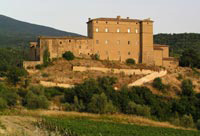 Castello di Potentino |
AZ. AGR. POTENTINO S.R.L. | Castello di Potentino, 58038 Seggiano Ref. Charlotte Mary Horton |Tel/Fax. 0564 950014 | e-mail castellodipotentino@virgilio.it AZ. AGR. LE QUERCIOLE | Podere Querciole, 58040 Montenero d'Orcia AZ. AGR. RABAGLI GIANNI | Pod. S. Margherita 58040 Cinigiano AZ. AGR. FRATELLI RONGO | AGRITURISMO POGGIO AL NINFALE | Loc. Montecucco Podere Sant'Agostino, 58044 Poggi del Sasso AZ. AGR. SALUSTRI | AGRITURISMO IL MANDORLO | Loc. La Cava 7, 58040 Poggi del Sasso AZ. AGR. SANTO STEFANO | Via G. Brodolini n.18, 58040 Montenero AZ. AGR. LIBERTARIO SAVELLI E CESIRA ROSSI | Pod. S. Roberto- Montenero 58040 Castel del Piano AZ. AGR. FRATELLI RONGO | AGRITURISMO POGGIO AL NINFALE | Loc. Montecucco Podere Sant'Agostino, 58044 Poggi del Sasso AZ. AGR. LA SCHIACCIONAIA | Via della Fontanella 1/3, 58031 | Loc. Bagnoli, Arcidosso AZ. AGR.TIBERI MIRENO | Loc. Serripori 12/b 58040 Montenero d'Orcia AZ. AGR. VEGNI, MEDAGLINI, GIANNETTI | Loc. Porrona Podere Poggio Paolo, 58044 Cinigiano AZ. AGR. LE VIGNE | 58040 Montenero
|
|||||||
Other Wines in Tuscany Tuscany is the epitome of perfect wine country, and hosts some of Italy's most famous appellations: Brunello di Montalcino, Chianti Classico, Nobile di Montepulciano, Vernaccia di san Gimignano, Carmignano and Super Tuscans with names such as Ornellaia, Sassicaia, Tignanello and Masseto.
|
||||||||
|
||||||||
Brunello di Montalcino Brunello di Montalcino |
||||||||
Vino Nobile di Montepulciano Vino Nobile di Montepulciano |
||||||||
The Chianti area The Chianti area
|
||||||||
| |
||||||||
|
||||||||
 |
 |
 |
||||||
Bolgheri Castle
|
Vigna del Masseto. Ornellaia e Masseto Società Agricola S.r.l..
|
|||||||
Podere Santa Pia Holiday Home Tour - YouTube
|
||||||||
|
||||||||
Biodynamic winemaking in Tuscany | Roses in Brunello di Montalcino vineyards, Montalcino Itinerari Trekking Costa degli Etruschi | Tenuta San Guido - Castiglioncello di Bolgheri
[1] Photo by y Francesco Sgroi, licensed under the Creative Commons Attribution 2.0 Genericlicense. |
||||||||
|
|
|||||||
|
||||||||

